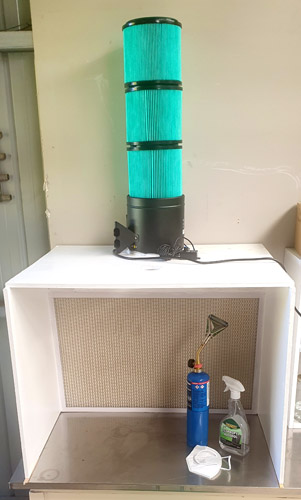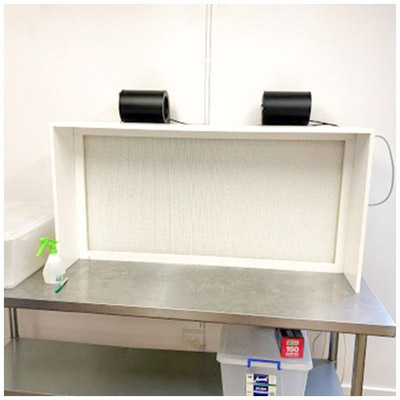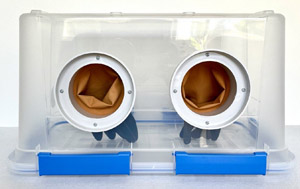I have recently made my own Laminar Flow Hood to enable me to sow Cymbidium orchid pods at home.
In the past I have relied on three different labs around Australia for my Cymbidium orchid flasking needs. I use each lab for a different reason and a different service. They are Western Orchids, Barrita Orchids, and Flora Laboratories.
Whilst the service is excellent from all three labs, the ability to sow green pods and replate my own flasks means I can control the timing and the cost of the service. And for the record, I will still use these three labs going forward for specific services. But for basic seed sowing and replating, I’ll be doing that myself from now on.
Some months ago out of the blue I was offered a proper full size laminar flow cabinet by a local grower. Unfortunately at the time, due to many constraints, I couldn’t take advantage of the opportunity. Something I now regret very much…… Fast forward six months, and I found myself in real need of being able to be self sufficient in basic sowing. I looked around and there were no large, proper laminar flow cabinet/benches available for cheap that I could find.
So, if I couldn’t have the real deal, the only thing to do was make a laminar flow hood myself. So after several hours searching the internet, I had decided on a model to use and started ordering my parts.
The Design
Firstly, I purchased a stainless steel table top from a local Facebook Marketplace seller for quite cheap. I really wanted to work on a surface that was easy to keep clean. Stainless Steel has to be the best option in my opinion, hence the extra expense I went to to obtain it.
For the design, I found a YouTube video on All the Gear, No Idea. This is pretty much a follow the bouncing ball tutorial on the concept, design and building of a DIY laminar flow hood. Hoocho is a very relatable Aussie who just finds a way to get it done! He makes some mistakes in the process of his build, so that we don’t have to! A list of parts Hoocho uses in the build is included in the description of the video, so everything you need is there. Have a watch of the video now. Then come back to this article for details on how I modified my build to suit me.
The Build

My design was based on Hoocho’s, however, I wanted some more space to work in. So my design ended up being wider that Hoocho’s with a bigger flat filter. The dimensions of my unit were about 620mm high, 760mm wide and 600mm deep. My flat filter was 30″ x 20″, so 4″ wider to give me some more room to work in. To decrease the weight of the box, I used 12mm plywood . I obtained my ply as offcuts from another Facebook Marketplace seller, so it was super cheap!
I purchased the same inline fan, which is quite an impressive unit. But I also added an extra Hepa filter (three in total) to increase the intake surface area for greater airflow. I’m sure there is another solution to purchasing a larger Hepa filter instead of three small ones. However I was able to source these 40% cheaper than retail, so it worked for me.
I have also mounted a light on the inside to ensure it’s nice and bright to work in. I painted my hood white using left over gloss anti mould bathroom paint from the shed to aid in cleaning when I need to.
So for under $500 I had a stainless steel table top and laminar flow hood that I was able to build myself, and quickly. And here it is!
The Results
So, what I ended up with was a much smaller version of the full size cabinet I wanted, however, it works the same! I have sown a bunch of green pods since my build and also replated several flasks. So far I have not had any contamination in the flasks, but I believe most of that comes down to the preparation.
The cleaning and disinfecting of the tools you use to work with is of utmost importance.
Disinfect your tools often and don’t use the same tools for different pods or flasks. Wear gloves and a mask, and spray everything down with isopropyl alcohol often. We also heat our tools on a flame to burn off any potential contaminants.
There are many You Tube videos out there that show you the techniques of preparing green pods for sowing and also the cleaning of your tools. And we will also post some of our own to assist you.
Here at Orchid Wise we use orchid sowing and replate tissue culture from Western Orchids. Western Orchids are local to us and we have had incredible results with this growing medium, seeing flasking times decrease to as little as 13-15 weeks from replating small plantlets. Germination is always a little unpredictable, but once they are growing, plants are kicking along at fantastically quick speeds. We couldn’t recommend Western Orchids tissue culture enough!
Other Options…..
Flat Pack Laminar Flow Hood

I have since found one of a number of websites in Australia that will provide a flatpack of pretty much the same hood that I made.
My hood though is deeper on the sides. Personally I think that may provide some better protection from contaminants working their way in.
Aussie Mushroom Supplies will supply little laminar flow hood flatpacks online. All you need to do is assemble it when it arrives! The benefit of a flat pack is that everything is included, whereas I had to purchase parts from various places and cut my timber to size.
They are certainly more expensive than what I was able to make, maybe about double my cost, but if DIY is not your thing, then this might be worth a try. The sizes vary, as do the costs, but a medium to large size would be very useable.
For our overseas friends, it seems DIY mushroom grow suppliers offer the best value for laminar flow flat packs, so search on Google and no doubt you will come up with a load of options.
Still Air Box
Another option you can build yourself at home is what is known as a Still Air Box. And a photo is below. No doubt cheaper than what I made for the budget conscious out there, and by all accounts just as effective in keeping the bugs out of your flasks. I know they have been used very effectively, even by very experienced flaskers as a home based solution.

Again, there are plenty of You Tube videos on Still Air Boxes and how to make them and use them effectively, or they can be purchased from places like eBay and etsy. A Google search is your best friend here!
So there it is. Get out there and build your own for a value way of expanding your hobby!
Happy flasking!
